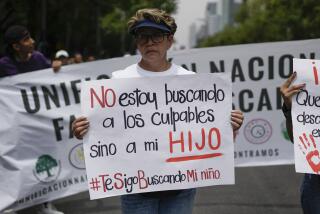Groups That Find Children Find It Pays to Advertise
- Share via
At least 100 missing children have been reunited with their families because people spotted their pictures on everything from milk cartons to advertising circulars, the executive director of a national organization said Thursday.
Jay Howell, executive director of the Washington-based National Center for Missing and Exploited Children, said the reunion this week in Costa Mesa of 9-year-old Monique Nicole Pace and her mother demonstrated “the way the system is supposed to work.”
The center, which gets federal funds but is not a government agency, received a call from a person who had seen a photograph of the child in a roster of missing children published in a newsletter distributed by Fuddruckers Restaurants.
The roster was compiled by Child Keyppers, a Lake Worth, Fla., group that distributes information about missing children. Child Keyppers also received phone calls from people who said they had seen the missing girl.
Both agencies contacted police in Hialeah, Fla., where the girl’s mother lived. They contacted Costa Mesa law enforcement authorities, who arrested the father this week.
“It’s an excellent example of so many different parties making that system work,” Howell said. “Five years ago that couldn’t have happened. It would have been impossible.”
But by February, 1985, Howell said, the publishing of pictures of missing children on milk cartons, shopping bags, in publications of private companies, newspapers, magazines and advertising circulars became widespread.
He said there now are more than 100 nonprofit groups around the country involved in some way in the problem of missing children, and perhaps one dozen or two dozen that publish pictures of children reported kidnaped.
One organization that works to recover children is the Orange County chapter of the Adam Walsh Child Resource Center, based in Orange.
The group’s victim services director, Pamela Harris-Oedekerk, said the organization has more than 400 volunteers and in the last eight months has played some part in getting missing children and parents back together. In some cases, the group simply provided airplane fares, but in about half the cases, it actually recovered the child, Harris-Oedekerk said.
She said the organization tracks down missing children primarily by “following up on leads we get from the parents, as well as sharing information with other persons who might be working on a case. That’s how all the work is done, through the networking. It’s like being a private detective, if you will.”
Harris-Oedekerk said the spotting and returning of Monique Nicole Pace is part of a trend “that seems to be increasing.”
“With the awareness that people have about missing children, these kids are being found left and right. That’s not to say there isn’t a problem,” she said. “One missing child is one too many.”
Harris-Oedekerk said the district attorney’s offices in San Bernardino and Orange counties have been active in tracking missing children, and the Adam Walsh center works closely with those offices and other law enforcement agencies.
The center was named for a boy who was kidnaped from a Florida shopping mall and was later found murdered. The story of his parents’ anguish and the attempt to find their son became a movie, and a sequel is scheduled for television on Sept. 29, Harris-Oedekerk said.
Jo Ann Currier, who founded Child Keyppers, said the group published a directory in July with the pictures of 152 children and distributed it nationwide. Of that number, 27 have been found--two of them after they were killed.
She said leads on missing children “came in various ways, not always the direct result of the directory.” But she said the booklet has been such a success that a second one is being prepared and there are plans to update it every three months.
In one case, Currier said, a woman saw a television program about Child Keyppers, called to report that her two children had been taken by their father more than 17 years earlier and wound up being reunited with her older son after Child Keyppers tracked him down.
The number of children who are abducted by strangers or a parent each year is disputed by professionals in the field. The state Department of Justice reported that 24,000 children were reported missing in California in 1984 but that only 550 were still lost after 30 days. Of these, only three had been abducted by strangers, officials said.
Most missing children are runaways or “throwaways”--children who have been kicked out of the house by their parents, according to statistics.
More to Read
Sign up for Essential California
The most important California stories and recommendations in your inbox every morning.
You may occasionally receive promotional content from the Los Angeles Times.













